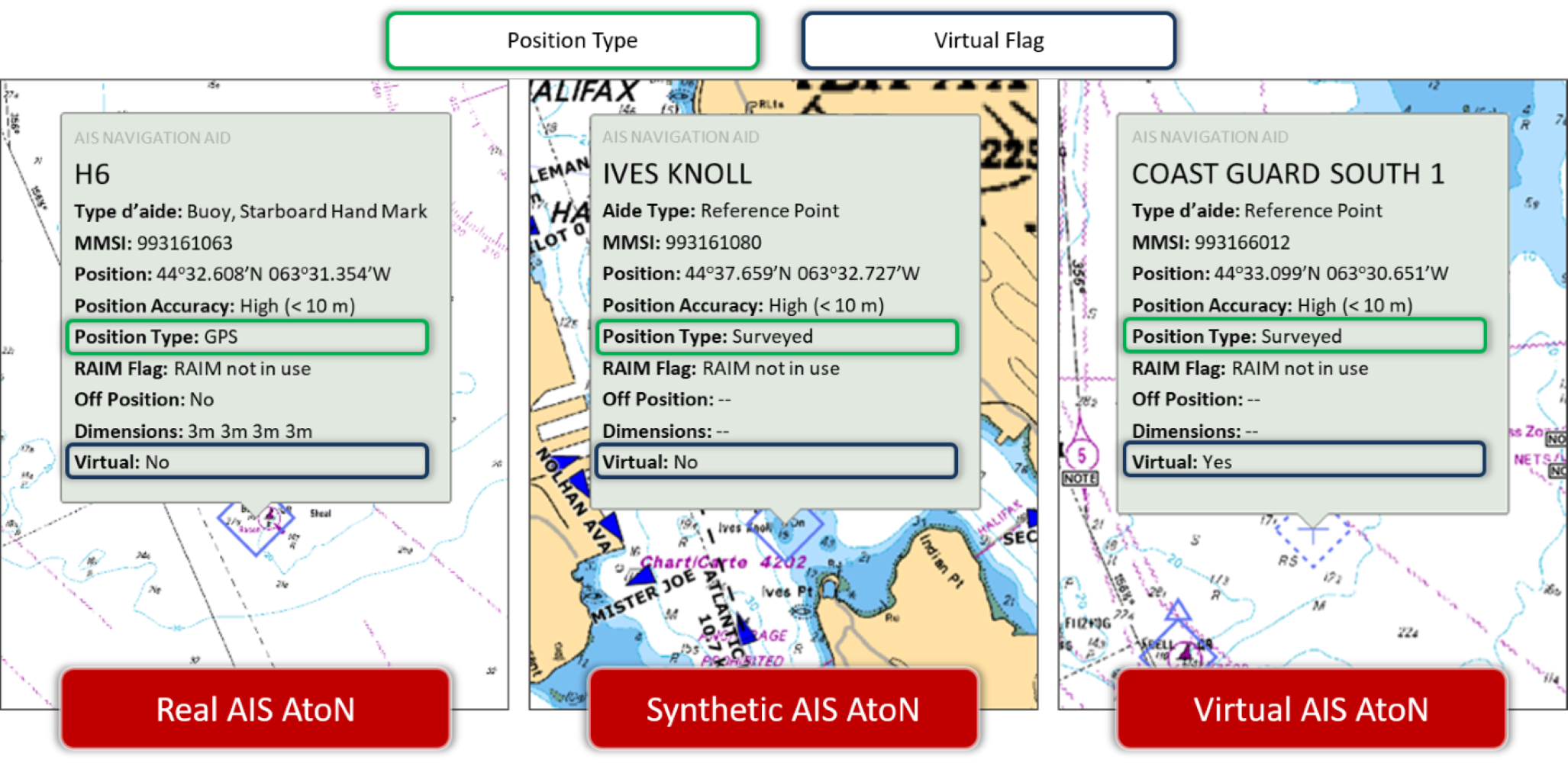Section 2. What is an AIS Aid to Navigation (AIS AtoN)?
An AIS AtoN is a digital aid to navigation that is broadcast by an authorized service provider using the AIS Message 21 (Aid to navigation report) and is displayed on navigation equipment such as the Electronic Chart Display Information System (ECDIS), radar, or an Integrated Navigation System (INS) (International Maritime Organization (IMO) MSC.1/Circ.1473).
The IMO, considering the mariner’s perspective, has recognized two types of AIS AtoN:
- Physical AIS AtoN (also known as a Real AIS AtoN) is an AIS Message 21 transmitted from an AtoN that physically exists
- Virtual AIS AtoN is transmitted as a Message 21 for an AtoN that does not physically exist.
The International Association of Marine Aids to Navigation and Lighthouse (IALA), having assessed the possibilities of AIS technology according to AtoN service providers (national authorities), has proposed a third type: the Synthetic AIS AtoN.
In accordance with IALA Recommendation R0126, Synthetic AIS AtoN are divided into two types: monitored and predicted.
- A Monitored Synthetic AIS AtoN is transmitted as a Message 21 from an AIS station that is located at a distance from the AtoN. The AtoN physically exists and communicates with the AIS station. This communication link confirms the position and status of the AtoN. A Monitored Synthetic AIS AtoN ensures the integrity of the Message 21 and can be considered an alternative to a Physical AIS AtoN.
- A Predicted Synthetic AIS AtoN is transmitted as a Message 21 from an AIS station located at a distance from the AtoN. The AtoN physically exists, but it is not equipped with a monitoring device to confirm its position and status. A Predicted Synthetic AIS AtoN cannot ensure the integrity of the Message 21 (position and status), and therefore it is not recommended for use on a floating aid. The use of a Predicted Synthetic AIS AtoN on a fixed aid is acceptable, as the position will not change, but the status of the AtoN is not verified.
Because information is transmitted using radio frequencies, each type of AIS AtoN must include a Maritime Mobile Service Identity (MMSI) number, which is obtained from Innovation, Science and Economic Development Canada (ISED).
| Type of AIS AtoN | MMSI (ITU-R M.585-5) | AIS AtoN coding parameter Virtual (ITU-R M.1317-4) | Positioning Mode |
|---|---|---|---|
| Physical | 99MID1xxx | 0 | GPS |
| Synthetic | 99MID1xxx | 0 | Surveyed |
| Virtual | 99MID6xxx | 1 | Surveyed |
A diamond-shaped symbol is used to represent an AIS AtoN on properly configured chart and radar systems. Physical and Synthetic AIS AtoN use a diamond shape with a solid line, while Virtual AIS AtoN use a dotted line (see Figure 2-1). The AIS AtoN information is displayed when you click the AIS AtoN symbol or move the cursor over it. As there is currently no specific recognized symbol for Synthetic AIS AtoN, the distinction between each type is made only by the MMSI number, the AIS AtoN coding parameters (virtual: yes/no), and the positioning mode (see Figure 2-2).


| Type of AIS AtoN | AtoN physically exists | Transmission origin of AIS Message 21 |
|---|---|---|
| Physical | Yes | AIS unit installed on an aid |
| Monitored Synthetic | Yes | AIS shore station |
| Predicted Synthetic | Yes | AIS shore station or AIS AtoN unit |
| Virtual | No | AIS shore station or AIS AtoN unit |
SEE ALSO:
Note on Maritime Mobile Service Identification. Any equipment capable of transmitting AIS messages must have a unique and approved MMSI. This includes Canadian-registered or Canadian-owned vessels, AIS coastal stations, and AIS AtoN. An MMSI must be requested and obtained from Innovation, Science, and Economic Development Canada (ISED). Further information regarding the procedures for the management of MMSIs, including how to obtain or cancel them, is available in the Circular CPC-2-3-07 — Obtaining Identities in the Maritime Mobile Service
Report a problem on this page
- Date modified: